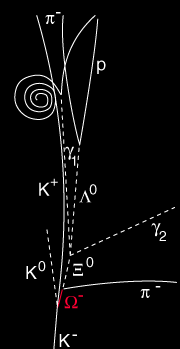The Xi Baryon
| Particle | Symbol | Makeup | Rest mass MeV/c2 | B | S | Lifetime | ||
Cascade | x10-10 | |||||||
Cascade | x10-10 |
 V. E. Barnes et al., Phys. Rev. Lett. 12, 204 (1964) |
The Xi or "cascade" baryon was seen in the same reaction which led to the discovery of the omega-minus baryon at Brookhaven in 1964. At left is a sketch of the bubble chamber photograph in which the omega-minus baryon was discovered. The decay of the Xi indicated in the diagram is  In this decay of the Xi particle, a lambda baryon and two gamma rays are shown as the products. Actually, the primary decay of the Xi is to a lambda-zero and a pi-zero meson. This cannot be a purely electromagnetic decay because strangeness is not conserved. Also, it's lifetime in the range of 10-10 seconds puts it in the common range for weak-interaction decays. It is just that the π0 decays into two gammas with a lifetime of about 10-16 seconds (an electromagnetic decay), so the two gamma rays appear to come from the same point as the lambda. |
We can hypothesize pathways for the decays of the Xi baryon by making use of Feynman diagrams and the quark transformation modes associated with the weak interaction.

Note that these are just suggestions of pathways. The Xi-minus decay certainly seems plausible and follows the pattern shown in other decays. The Xi-zero decay is going a bit further out on a limb since it invokes two W-bosons. It is a slower process, but one would think that a double-W process would inhibit the decay by a larger factor.
| Table of Baryons | Baryon Diagram |
| Table of quark properties | Conservation of Strangeness |
Particle concepts
| HyperPhysics***** Quantum Physics | R Nave |